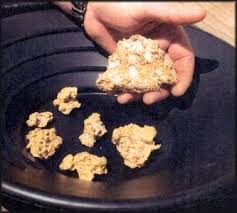

| Symbol: | Au |
| Melting point: | 1,064 °C |
| Electron configuration: | [Xe] 4f14 5d10 6s1 |
| Atomic number: | 79 |
| Atomic mass: | 196.96657±0.000004u |


| Ore | Common Name | Formula |
|---|---|---|
| Native gold | Native gold | Au |
| Gold Amalgam | Gold Amalgam | Au,Hg,Ag |
| Tellurides | Sylvanite | Au,Ag,Te2 |
| Tellurides | Calaverite | Au,Ag,Te2 |
| Tellurides | Petzite | Au,Ag,Te2 |
Gold occurs in native form. It is yellow or golden yellow in color. Its density is very high. Its thermal and electrical conductivity are very good. Gold is malleable and ductile in nature. It is used for making coins and jewelries. It is also used for gold electroplating on the surface of silver and copper. Gold chloride is used in electro plating and as a toning agent in photography. Gold is alloyed with copper and silver. Alloys of gold are also used in coins and jewelries. Gold has an important position in the world economy. It is used as a medium of exchange and security cover for paper currency. The major producer of gold in the world is South Africa. More than half of the world production of gold is produced by South Africa. Other producers of gold are Canada, USA, Brazil, Australia, Russia, China, Ghana, Zimbabwe, Chile, Columbia and Papua New Guinea. Gold occurs in combination with tellurides and selenides. Gold also occurs as amalgam of mercury and silver. Some telluride minerals having gold are sylvanite, calaverite, petzite and nagyagite.



Native gold is recovered from alluvial deposits by panning of gold bearing sands, and concentration by continuous washing.
The gold bearing sand concentrate is introduced to a sluice way system. A powerful stream of water is passed over it.
A sluice way system is an inclined channel provided with a series of sluices. The gold particles are retained in the sluice, while the sand is carried away by the water.
The slurry containing finer particles of gold is passed over amalgamated copper plates to which the gold particles adhere.
The gold amalgam thus formed is scrapped and distilled in iron retorts. Mercury distils over leaving the gold particles at the bottom of the retort.
When the gold content is low and the rock containing gold is refractory in nature, the MacArthur-Forest cyanide process is used.
Gold bearing rocks associated with sulphides and tellurides are concentrated by froth floatation process. The concentrate is roasted to remove all the oxidisable impurities
such as tellurium, sulphur and arsenic. The roasted ore is treated with a solution of potassium cyanide for some days.
In the atmospheric condition, gold dissolves in potassium cyanide solution. Scraps of zinc are added to the solution. Gold particles precipitate slowly.
4Au + 8KCN +2H2O+ O2 -> 4K[Au(CN)2]+4KOH
2K[Au(CN)2] + Zn -> K2[Zn(CN)4]+2Au
The impurities like silver, copper, lead and zinc remain with gold. Sod refining is required to produce pure gold. At the first stage the impure gold is heated with borax silica base. Supply of air is continued by blowing air. The impurities like lead and zinc are oxidized and separated. The gold is free of such impurities. But impurities like silver and copper remains. So, the gold is treated with concentrated sulphuric acid. Silver and copper react with the acid and become salt. Thus, Gold is separated as a pure metal.

But electro-refining of gold is also carried out. The electrolyte used is a combination of gold chloride and hydrochloric acid. Thin plates of gold are used as cathode and blocks of impure gold are used as anodes. Under current action, gold dissolves from the anode and deposits at the cathode. Gold from anode does not dissolve in gold chloride solution due to passivation. However, in the presence of chloride ions gold dissolves in the solution as monovalent and trivalent ions. Excess of chlorine ions can be provided by the addition of small amount of hydrochloric acid. Equilibrium is established between mono and trivalent ions at the anode. Gold deposits on the cathode as a dense and hard layer. Cathodic deposition is possible due to secondary reactions between the gold containing anions and the product of primary reactions. The metallic impurities partly pass into solution and partly collect in the anodic sludge. Gold produced is about 99.80 percent pure. The electrolyte is charged at regular interval to prevent the excessive accumulation of impurities like gold, platinum and palladium. Gold is recovered from the exhausted electrolyte by treatment with sulphur dioxide. The anodic sludge is melted to have impure gold for future treatment.